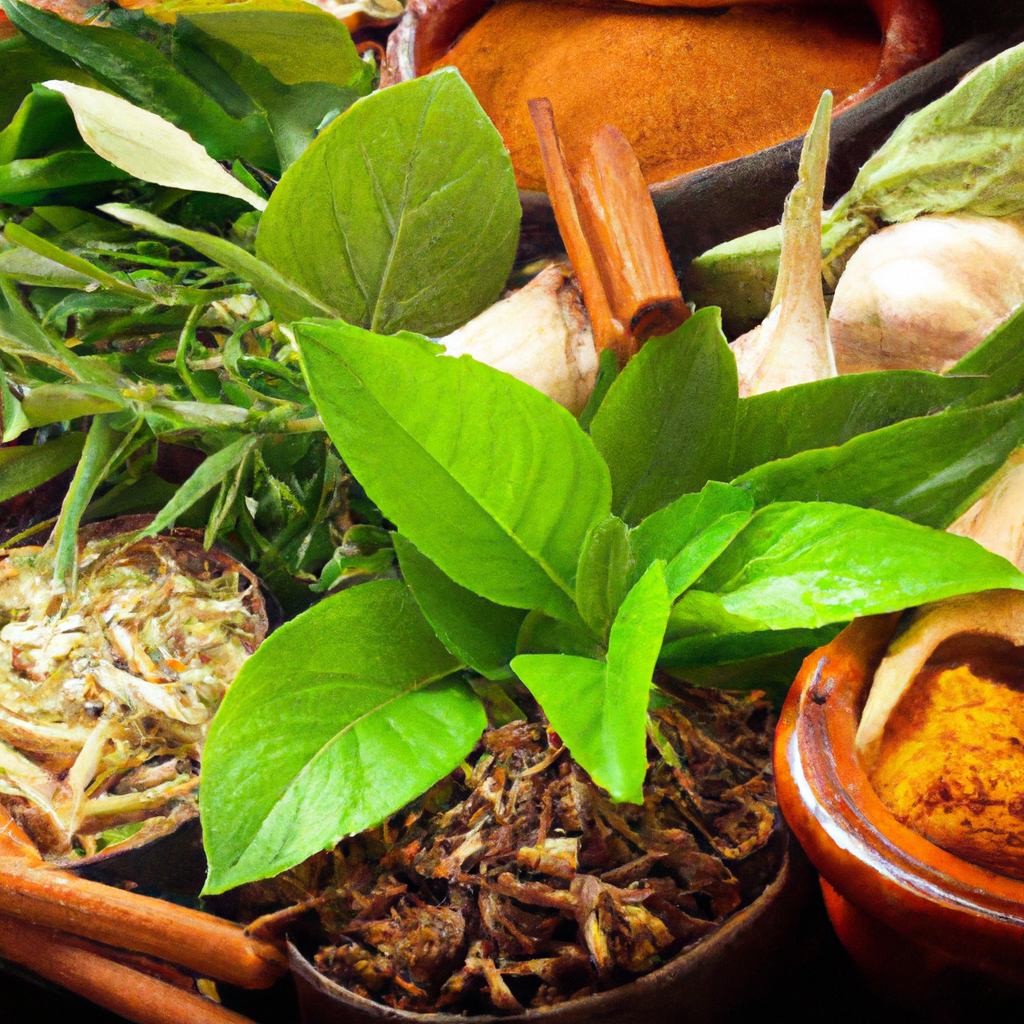
Nothing elevates a culinary creation quite like the addition of herbs. From their aromatic fragrance to their vibrant colors, herbs possess the power to transform ordinary dishes into extraordinary culinary experiences. With their versatility and ability to enhance flavors, herbs have become an essential ingredient in countless cuisines around the world. However, there is more to herbs than meets the eye. In this article, we will explore the diverse range of herbs and microgreens available, and how they can be used to elevate your cooking to new heights. Get ready to embark on a journey of exploration, as we unlock the secrets of the endless possibilities that herbs bring to our plates.

Herbs in Culinary Dishes
Herbs play a vital role in enhancing the flavors and aromas of culinary dishes, and they also provide a delightful texture. Whether you’re a seasoned chef or an amateur cook, incorporating herbs into your cooking can take your dishes to a whole new level.
Enhancing Flavor
One of the primary reasons herbs are used in culinary dishes is to enhance the flavors of various ingredients. The addition of herbs brings a depth and complexity to your dishes that can’t be achieved through other means. Each herb has its unique flavor profile, ranging from earthy and robust to fresh and citrusy, allowing you to experiment and create a harmonious balance in your recipes.
Adding Aromas
The aromatic properties of herbs can transform a simple meal into a culinary sensory experience. From the aromatic notes of basil to the piney scent of rosemary and the fragrant allure of thyme, herbs have the power to tantalize your sense of smell, making your food more enticing and appetizing.
Providing Texture
In addition to flavor and aroma, herbs also bring an element of texture to culinary dishes. Whether you choose to use fresh herbs as a garnish or incorporate them into a sauce or marinade, they add a delightful pop of color and a subtle crunch that can elevate a dish from ordinary to extraordinary.
Common Culinary Herbs
Several common culinary herbs are frequently used in a wide range of dishes. Let’s take a closer look at some of the most popular ones:
Basil
Basil, with its distinct aroma and vibrant green leaves, is a staple herb in Mediterranean and Asian cuisines. It adds a fresh and slightly peppery flavor, making it an excellent addition to salads, pasta sauces, pesto, and even cocktails.
Rosemary
Rosemary, known for its woody fragrance, is commonly used in dishes like roasted meats, potatoes, and bread. Its robust flavor profile pairs well with hearty ingredients and adds a touch of earthiness to various savory dishes.
Thyme
Thyme is a versatile herb that adds a subtle and earthy flavor to a wide range of dishes, including soups, stews, roasted vegetables, and marinades. The small leaves of this herb release a fragrant aroma when cooked, infusing your meals with a delightful essence.
Parsley
Parsley, with its vibrant green color and fresh taste, is often used as a garnish or added to sauces, salads, and marinades. It brings a bright and slightly tangy flavor that complements a variety of dishes, making it a must-have in any herb garden.
Mint
Mint is a refreshing herb that adds a cool and invigorating element to both sweet and savory dishes. It pairs well with fruits, desserts, salads, and meat dishes, bringing a burst of freshness and a hint of sweetness.

Health Benefits of Herbs
Not only do herbs enhance the flavors of your dishes, but they also offer numerous health benefits. Here are some of the advantages of incorporating herbs into your culinary repertoire:
Boosting Immune System
Many herbs, such as basil and thyme, contain essential vitamins, minerals, and antioxidants that can help boost your immune system. These natural compounds help fight off infections and support overall health and well-being.
Improving Digestion
Certain herbs, like rosemary and mint, have been used for centuries to aid digestion. They can help alleviate digestive issues such as bloating, indigestion, and stomach cramps, making your meals more enjoyable and easier to digest.
Reducing Inflammation
Several herbs, including parsley and basil, possess anti-inflammatory properties. Regular consumption of these herbs may help reduce inflammation in the body, which is linked to various chronic diseases, such as heart disease and arthritis.
Herb Infused Oils and Vinegars
Herb-infused oils and vinegars are a simple and versatile way to incorporate herbs into your culinary creations. They can be used in a variety of dishes to add depth of flavor and a hint of herbaceousness. Here’s how you can make and use herb-infused oils and vinegars:
Simple Infusion Method
To make herb-infused oils and vinegars, you’ll need fresh herbs, high-quality oil or vinegar, and a clean glass container. Simply bruise the herbs slightly to release their oils, then place them in the container and cover them with the oil or vinegar. Let the mixture infuse for several days or weeks, shaking occasionally to incorporate the flavors. Strain out the herbs before using the infused oil or vinegar in your recipes.
Versatile Uses
Herb-infused oils can be used as a dressing for salads, a marinade for meats, or a flavorful base for sautéing vegetables. Herb-infused vinegars, on the other hand, can be drizzled over roasted vegetables, used in salad dressings, or added to sauces and marinades for a tangy kick.
Storage Tips
To ensure the longevity of your herb-infused oils and vinegars, store them in a cool, dark place. This will help preserve their flavors and prevent them from going rancid. Additionally, make sure to use clean utensils when extracting the oils or vinegars to prevent any cross-contamination.

Herbal Teas and Infusions
Herbal teas and infusions are not only soothing and comforting, but they also offer a myriad of flavors and health benefits. By combining different herbs and botanicals, you can create flavorful blends that promote relaxation, wellness, and even specific purposes. Here’s a closer look at herbal teas and infusions:
Creating Flavorful Blends
By combining herbs such as chamomile, lavender, and lemon balm, you can create a calming and floral tea blend. For a more invigorating option, consider blending peppermint, ginger, and lemongrass. The possibilities are endless, allowing you to tailor your tea blends to your personal preferences.
Promoting Relaxation and Wellness
Certain herbal teas, like chamomile and valerian root, have calming properties that can help reduce stress and anxiety, leading to better sleep and overall well-being. Other herbs, such as echinacea and elderberry, are known for their immune-boosting properties, making them an excellent choice during the cold and flu season.
Variations for Different Purposes
In addition to relaxation and wellness, herbal teas can also be created for specific purposes. For example, a blend of ginger, lemon, and honey can soothe a sore throat, while a combination of mint and fennel can aid in digestion. Explore the world of herbal teas and infusions to discover the possibilities and find the blends that resonate with you.
Herbs in Salads and Dressings
Fresh herbs are a wonderful addition to salads and dressings, adding vibrancy, flavor, and a burst of freshness. Whether you’re creating a simple herb salad or whipping up a homemade vinaigrette, herbs can take your salads to the next level.
Fresh Herb Salad
A fresh herb salad is a great way to showcase the flavors and textures of different herbs. Combine a variety of fresh herbs such as parsley, basil, mint, and dill with mixed greens for a vibrant and refreshing salad. Toss in some cherry tomatoes, cucumbers, and a simple vinaigrette to complete the ensemble.
Herb Vinaigrette
Making your own herb vinaigrette allows you to customize the flavors and tailor them to your taste. Combine olive oil, vinegar (such as red wine or balsamic), minced garlic, Dijon mustard, and a medley of chopped herbs like thyme, rosemary, and oregano. Shake or whisk together to create a tangy and herb-infused dressing perfect for drizzling over salads or using as a marinade.
Herb Garnishes
Lastly, don’t forget to use fresh herbs as garnishes for your salads. Sprinkle some chopped mint or basil over a fruit salad to add a refreshing twist, or top a savory salad with a sprinkle of minced chives or cilantro for an added burst of flavor.

Herbal Seasonings and Rubs
Creating custom herb blends for seasonings and rubs allows you to infuse your dishes with unique flavors and aromas. Whether you’re grilling meats or roasting vegetables, herbal seasonings and rubs can take your culinary creations to new heights.
Creating Custom Blends
Experimenting with different herbs and spices can lead to some truly remarkable flavors. Combine herbs like thyme, oregano, and sage with spices such as paprika, cumin, and chili powder to create a versatile savory seasoning. For a Mediterranean-inspired rub, mix dried rosemary, dried parsley, garlic powder, and lemon zest.
Enhancing Meats and Vegetables
Herbal seasonings and rubs are excellent for enhancing the flavors of meats and vegetables. Whether you’re grilling a steak or roasting a chicken, a generous sprinkle of your custom herb blend will add depth and complexity to the dish. Rub the seasoning directly onto the meat or toss vegetables in the blend before roasting for an irresistible aromatic infusion.
Application Techniques
When applying herb seasonings and rubs, ensure that you distribute the mixture evenly across the surface of the meat or vegetables. Pat them dry before rubbing in the seasoning to allow for better adhesion. For best results, let the seasoned meat or vegetables sit for a while to allow the flavors to meld before cooking.
Herbs in Soups and Stews
Herbs are a critical ingredient in creating delicious and flavorful soups and stews. They add depth and complexity to the broth, infuse it with aromatic qualities, and create a well-rounded taste that will keep you coming back for more.
Flavorful Broth Base
When making soups and stews, herbs can be used to create a flavorful broth base. Simmering herbs such as bay leaves, thyme sprigs, and parsley stems in the broth allows their flavors to infuse and permeate throughout the dish. These herbs provide a subtle background flavor that elevates the overall taste and aroma of the soup or stew.
Herb Bouquet Garni
An herb bouquet garni is a classic technique used to infuse soups and stews with herbal flavors. It involves tying together a bundle of fresh or dried herbs, such as thyme, rosemary, and parsley, with kitchen twine. This bundle is then added to the soup or stew during the cooking process and removed before serving. This method allows for easy removal of the herbs while imparting their flavors into the dish.
Slow-cooked Infusion
Another way to incorporate herbs into soups and stews is through slow-cooking methods. When simmered for an extended period, herbs like thyme, bay leaves, and rosemary release their flavors gradually, resulting in a deeply infused and richly flavored dish. The gentle infusion over time allows the herbs to meld with the other ingredients, creating a well-balanced and delicious end product.

Herbs in Baking and Desserts
While herbs are often associated with savory dishes, they can also be a delightful addition to baking and desserts. The inclusion of herbs in sweet treats can bring surprising and sophisticated flavors that will tantalize your taste buds.
Infused Sugar and Syrups
Infusing sugar and syrups with herbs is an excellent way to incorporate their flavors into baked goods and desserts. Start by placing a handful of fresh herb stems, such as lavender or rosemary, in a jar of granulated sugar or simple syrup. Allow the herbs to infuse for a few days, and you’ll have an aromatic and herb-infused sweetener or syrup to use in recipes like cakes, cookies, or cocktails.
Herb-Infused Whipped Cream
Adding a subtle herbaceous twist to whipped cream can take your desserts to a whole new level. Gently bruise fresh herbs, such as mint or basil, and add them to chilled heavy cream. Let the mixture steep for about an hour, then strain out the herbs before whipping the cream as usual. The resulting herb-infused whipped cream can be used to top pies, cakes, or even hot cocoa for a unique and delightful flavor experience.
Sweet and Savory Herb Combinations
Don’t be afraid to experiment with sweet and savory herb combinations in your baking and desserts. For example, incorporating thyme into a lemon cake can add a subtle earthiness that complements the bright citrus flavors. Similarly, adding a touch of basil to a strawberry shortcake can provide a delicate and refreshing twist. The key is to balance the flavors to create a harmonious blend that enhances your sweet treats.
Preserving and Drying Herbs
To enjoy the flavors and aromas of herbs throughout the year, it’s essential to preserve them properly. Here are a few methods for preserving and drying herbs:
Air Drying Method
Air drying is one of the oldest and simplest methods of preserving herbs. Gather the herbs in small bundles and hang them upside down in a well-ventilated area away from direct sunlight. Allow the herbs to dry completely, then remove the leaves from the stems and store them in airtight containers. This method preserves the flavors and aromas of the herbs while ensuring their longevity.
Freezing Techniques
Freezing is another effective way to preserve herbs, especially those with delicate leaves like basil and cilantro. To freeze herbs, wash and pat them dry, then chop or leave them whole. Place them in ice cube trays and cover with a small amount of water or oil. Once frozen, transfer the herb cubes to a resealable bag or container for long-term storage. This method allows you to have herbs at your fingertips year-round.
Long-term Storage Tips
For long-term storage of dried herbs, keep them in airtight containers in a cool, dark place. Make sure to label the containers with the name of the herb and the date of drying to ensure freshness. Properly stored dried herbs can retain their flavors and aromas for up to a year.
In conclusion, herbs are incredibly versatile ingredients that can enhance the flavors, aromas, and textures of culinary dishes. From adding a burst of freshness to salads to infusing oils, vinegars, and teas, herbs offer a myriad of possibilities to explore in the kitchen. Whether you’re a seasoned chef or a home cook, incorporating herbs into your cooking will take your dishes to new heights of flavor and creativity. So don’t be afraid to experiment and embrace the abundant world of culinary herbs.





